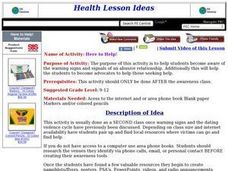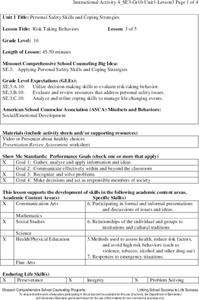Curated OER
Economics: Property Rights and the Rule of Law
Learners examine the economic value of property rights. In a classroom activity, "You're the Economist," they analyze actual research data from establishing land holding titles in Para, Brazil. They assess several case studies about the...
Curated OER
What Does Advertising Say About Smoking?
Students analyze the decision to smoke and how it is influenced by peer pressure. The discuss ways to say no to tobacco use.
Curated OER
Building a Healthy City (Final Project)
Students construct a scaled model of a city that provides for the economic and cultural needs of a community while maintaining high quality air and water to protect the public health. They articulate, in a presentation, the locations of...
Curated OER
Here to Help!
The purpose of this activity is to help students become aware of the warning signs and signals of an abusive relationship. Additionally this will help the students to become advocates to help those seeking help.
Curated OER
Powerful Potato
Third graders recognize the importance of geography in shaping a settlement where people can live. In this community location lesson, 3rd graders participate in a potato growing activity to understand how it helped a community...
Curated OER
Standing Review - A Learning and Assessment Technique
Young scholars review information covered in class through participation in action activities. The class begins standing as the teacher asks a question. Students may mingle to obtain assistance. Young scholars sit when they are...
Curated OER
Nutritionist for Hire
Tenth graders role play that they are nutritionists devising a healthy dietary plan that focuses on the client's needs.
Curated OER
Tiny Bites: What Difference Could They Make?
Students explore how small "extra" bites of food can add significant calories to their diet. They estimate how many extra calories they add to their diets by just taking small bites of food throughout the day.
Curated OER
Geography Made Fun with Technology
Students incorporate knowledge box into their classroom activities. In this technology integration lesson, students fill out a graphic organizer using Glossopedia to analyze a new subject.
King Country
Lesson 9: Communication - Day 2: Assertiveness
Appropriate assertive and non-verbal assertive communication is the focus of this lesson designed for the special education classroom. Using mirrors, class members practice assertive responses to a variety of situations.
Missouri Department of Elementary
Fatal Accident
While there may not be any ghostbusters in the neighborhood, there are plenty of emergency response agencies ready to give support if something is amiss. To that end, instructors invite a member of an emergency response agency to address...
Missouri Department of Elementary
Risk Taking Behaviors
Sophomores can be sometimes wise and sometimes foolish. The same can be said for their behaviors. After watching a presentation about risk taking behaviors, class members discuss the presentation in small groups, and then complete a...
Missouri Department of Elementary
My Feelings
Encourage self-awareness with a lesson that challenges scholars to identify feelings—happy, sad, mad, and scared. Using a feelings thermometer, similar to that of a bar graph, pupils discuss how they would feel in specific scenarios then...
Curated OER
October: Respect for Self and Others
Students realize their worth and dignity as human beings and account for their strengths as well as display their weaknesses. They display good manners and politeness, showing the respect for others as they would wish for themselves....
Curated OER
Fire Safety (Stop, Drop & Roll)
Third graders review what to do in case they are faced with a fire in their homes or school. They review what to do if they are faced with moving safely within a structure that is on fire. Students play a Tag Game together to reinforce...
Curated OER
The Quicker the Better? Food Processing
Sixth graders explore food processing. In this food processing activity, 6th graders investigate the effects of processing foods on the food's nutritional value. Students examine a variety of healthy snack options.
Curated OER
Smoking Out Valid Information About Smoking
Eighth graders work in teams to investigate the authority, accuracy, objectivity, currency & coverage of web sites related to tobacco use. They have previously been taught the concepts of authority, accuracy, objectivity, currency...
Curated OER
Get Your Calcium-Rich Foods
Sixth graders explore foods in the dairy group. In this dairy food lesson plan, 6th graders examine the nutritional value of dairy foods and determine the proper number of dairy servings per day. Students also evaluate numerous food...
Curated OER
Wiffle Tag
Students participate in a Wiffle Tag game. Students tag other classmates by touching a designated body part. The name of the body part changes each time someone is tagged. Students practice listening and following directions.
Curated OER
My Pyramid Tag
Students explore the new My Pyramid five healthy food groups and their benefits. They become familiar with the five healthy food groups and the colors that represent each food group in the new My Pyramid.
Curated OER
Litter Recognition
Students identify litter, and discuss what to do with it. They analyze people's response to litter. Some people may ignore it, while others may pick it up. They observe student behavior as part of an experiment.
Curated OER
Personal Fitness
Students research important personal fitness and sport concepts through note taking, internet research, data collection, and the website Quia. Development of concept maps are also encouraged.
Curated OER
Food Pyramid
Second graders are introduced to the food groups on the food pyramid. Individually, they draw pictures of their favorite foods and identify which food group it belongs. To end the lesson, they discuss the importance of eating a variety...
Curated OER
Getting the Most Nutrition From Your Food
Fifth graders research the food pyramid. In this food pyramid lesson, 5th graders track their eating habits during the day. Later, students review their food log and place each item into the food pyramid.

























